New Books: November 2020
1.) Acidophiles: Life in Extremely Acidic Environments
Author: Raquel Quatrini (Editor), D. Barrie Johnson (Editor)
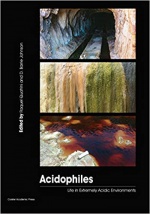
| TD195.42 .A181 2016 Book Description Acidophiles are life-forms that grow preferentially in natural or man-made environments where the pH is well below seven. Together with other categories of extremophiles, they have greatly expanded our knowledge of the diversity of life, our understanding on how microorganisms can adapt to seemingly hostile situations, and provided scenarios for the possibility that life-forms may be found outside of our solar system. Written by experts in their field, this important volume provides a comprehensive account of acidophilic microbiology from fundamental to applied aspects. The seventeen chapters are arranged in five sections, each dealing with a specific area. The first section looks at the challenges faced by life-forms that grow in extremely acidic environments and how they adapt to meet these challenges. The next section describes the physiological and phylogenetic diversities of acidophilic microorganisms including archaea, bacteria and eukaryotes. Section three covers acidophile community dynamics, quorum sensing and the formation of biofilms. The next section deals with the various omic technologies that are used to study acidophiles including genomic and metagenomic studies, proteomic-, mobilomic- and metabolomic-focused research. The final section considers the ways in which acidophiles are used in established and emerging biotechnologies and describes why these fascinating microorganisms are considered potential candidates for life on other solar bodies, such as Mars, and beyond. (amazon.com) |
2.) The Handbook of Metabonomics and Metabolomics
Author: John C. Lindon (Editor), Jeremy K. Nicholson (Editor), Elaine Holmes (Editor)
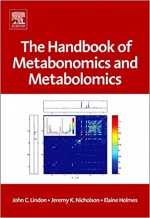
|
QH506 H236 2007 Book Description The Handbook of Metabonomics and Metabolomics aims to be the definitive work on the rapidly expanding subjects of metabolic profiling, metabolite and biomarker identification, encompassing the fields of metabonomics and metabolomics. It covers the principles of the subject, the analytical and statistical techniques used and the wide variety of applications. (amazon.com) |
3.) Proteomic and Metabolomic Approaches to Biomarker Discovery
Author: Haleem J. Issaq (Editor), Timothy D. Veenstra (Editor)
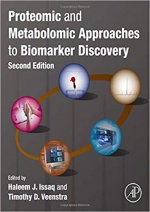
| QH438.4.B55 P967 2020 Book Description Proteomic and Metabolomic Approaches to Biomarker Discovery, Second Edition covers techniques from both proteomics and metabolomics and includes all steps involved in biomarker discovery, from study design to study execution. The book describes methods and presents a standard operating procedure for sample selection, preparation and storage, as well as data analysis and modeling. This new standard effectively eliminates the differing methodologies used in studies and creates a unified approach. Readers will learn the advantages and disadvantages of the various techniques discussed, as well as potential difficulties inherent to all steps in the biomarker discovery process. This second edition has been fully updated and revised to address recent advances in MS and NMR instrumentation, high-field NMR, proteomics and metabolomics for biomarker validation, clinical assays of biomarkers and clinical MS and NMR, identifying microRNAs and autoantibodies as biomarkers, MRM-MS assay development, top-down MS, glycosylation-based serum biomarkers, cell surface proteins in biomarker discovery, lipodomics for cancer biomarker discovery, and strategies to design studies to identify predictive biomarkers in cancer research. (amazon.com) |
4.) Tapping Molecular Wilderness: Drugs from Chemistry, Biology, and Biodiversity Interface
Author: Yongyuth Yuthavong (Author)
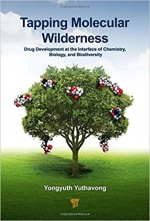
| RM301.25 Y81T 2016 Book Description This book is for readers with some background in science, concerning the search for drugs, starting from molecular diversity in nature or molecular wilderness. Drug molecules may be used as such, or as starting points for improved drugs obtained from the interface of chemistry and biology. In some cases, the essential molecular features for drug properties from natural molecules may be identified and modified to more effective ones. In other cases, nature provides the targets, such as essential enzymes from infectious microorganisms, from which synthetic drugs can be designed. The mechanisms of action of drugs can be discerned by studying target–drug interactions. Nature may fight back, as in cases when microorganisms become resistant to drugs, but we can again use the chemistry–biology interface to obtain drugs which overcome the resistance. The battle goes on, hopefully with victory for both humans and balance of nature. This book differs from those available on the subject of natural products and drugs derived therefrom in that it looks at the broad picture on how materials and organisms from nature affect our health and how we have combined our knowledge in chemistry, biology, and biodiversity to promote our wellness from resources in the “molecular wilderness,” with caveats on sustainable utilization of these resources. It is therefore suitable, not only for readers interested in science and medicine, but also for those with interest in policy issues concerning sustainable development, environment, and issues concerning interaction of science and society in general. (amazon.com) |
5.) Sparks from the Spirit: From Science to Innovation, Development, and Sustainability
Author: Yongyuth Yuthavong (Author)
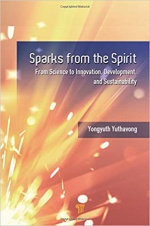
| Q175.5 Y81S 2018 Book Description The sparks from the spirit of science include not only new knowledge but also innovations, the major ingredients of development and sustainability. This book creates an understanding of science and its role in innovation and sustainable development and points out unfilled gaps in human development. It highlights opportunities for societies to overcome obstacles in development. The book is written in an easy-to-understand manner, avoiding technical jargon, and contains case studies, practical examples, and historical perspectives. It is intended for a general, especially young readership and will appeal to those curious about the nature of science and its benefits, together with its possible pitfalls. (amazon.com) |
6.) Alternative Solvents for Natural Products Extraction (Green Chemistry and Sustainable Technology)
Author: Farid Chemat (Editor), Maryline Abert Vian (Editor)
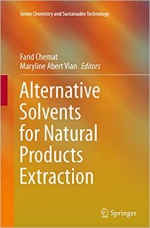
| TP155.2.E58 A466 2014 Book Description This book presents a complete picture of the current state-of-the-art in alternative and green solvents used for laboratory and industrial natural product extraction in terms of the latest innovations, original methods and safe products. It provides the necessary theoretical background and details on extraction, techniques, mechanisms, protocols, industrial applications, safety precautions and environmental impacts. This book is aimed at professionals from industry, academicians engaged in extraction engineering or natural product chemistry research, and graduate level students. The individual chapters complement one another, were written by respected international researchers and recognized professionals from the industry, and address the latest efforts in the field. It is also the first sourcebook to focus on the rapid developments in this field. (amazon.com) |
7.) Data Visualisation with R: 111 Examples (2nd ed.)
Author: Thomas Rahlf (Author)
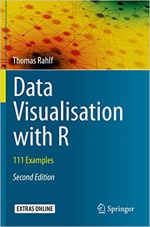
|
QA76.9.I52 R147D 2019 Book Description This book introduces readers to the fundamentals of creating presentation graphics using R, based on 111 detailed and complete scripts. It shows how bar and column charts, population pyramids, Lorenz curves, box plots, scatter plots, time series, radial polygons, Gantt charts, heat maps, bump charts, mosaic and balloon charts, and a series of different thematic map types can be created using R’s Base Graphics System. Every example uses real data and includes step-by-step explanations of the figures and their programming. This second edition contains additional examples for cartograms, chord-diagrams and networks, and interactive visualizations with Javascript. The open source software R is an established standard and a powerful tool for various visualizing applications, integrating nearly all technologies relevant for data visualization. The basic software, enhanced by more than 14000 extension packs currently freely available, is intensively used by organizations including Google, Facebook and the CIA. The book serves as a comprehensive reference guide to a broad variety of applications in various fields. This book is intended for all kinds of R users, ranging from experts, for whom especially the example codes are particularly useful, to beginners, who will find the finished graphics most helpful in learning what R can actually deliver. (amazon.com) |
8.) Mass Spectrometry-Based Metabolomics: A Practical Guide (1st ed.)
Author: Sastia Prama Putri (Editor), Eiichiro Fukusaki (Editor)
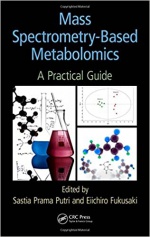
| QP171 M414 2015 Book Description Mass Spectrometry-Based Metabolomics: A Practical Guide is a simple, step-by-step reference for profiling metabolites in a target organism. It discusses optimization of sample preparation for urine, serum, blood, tissue, food, and plant and animal cell samples. Encompassing three different technical fields―biology, analytical chemistry, and informatics― mass spectrometry-based metabolomics can be challenging for biologists without special training in quantitative mass spectrometry. This book is designed to overcome this limitation by providing researchers with the knowledge they need to use metabolomics technology in their respective disciplines. The book summarizes all steps in metabolomics research, from experimental design to sample preparation, analytical procedures, and data analysis. Case studies are presented for easy understanding of the metabolomics workflow and its practical applications in different research fields. The book includes an in-house library and built-in software so that those new to the field can begin to analyze real data samples. In addition to being an excellent introductory text, the book also contains the latest advancements in this emerging field and can thus be a useful reference for metabolomics specialists. (amazon.com) |
9.) The Handbook of Plant Metabolomics
Author: Wolfram Weckwerth (Editor), Guenter Kahl (Editor)
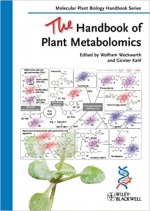
| QK881 H236 2013 Book Description This is the newest title in the successful Molecular Plant Biology Handbook Series. Just like the other titles in the series this new book presents an excellent overview of different approaches and techniques in Metabolomics. Contributors are either from ivy-league research institutions or from companies developing new technologies in this dynamic and fast-growing field. With its approach to introduce current techniques in plant metabolomics to a wider audience and with many labs and companies considering to introduce metabolomics for their research, the title meets a growing market. The Kahl books are in addition a trusted brand for the plant science community and have always sold above expectations. (amazon.com) |
